Howard Carter is the British archaeologist who first excavated King Tut’s tomb. Imagine what it was like to be him and rediscover a treasure that had been unseen for three thousand years. I wonder if that was what is was like for Sandor Nagyszalanczy in 1988.
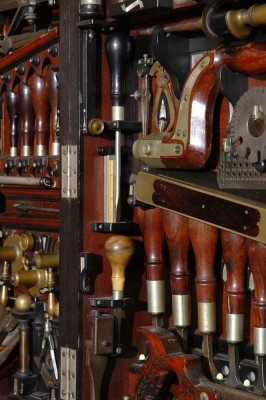
Earlier this week I had the pleasure of speaking with Sandor Nagyszalanczy, prolific author and former Senior Editor of Fine Woodworking. I’d been trying to find someone who could provide that institutional/historical context for the emergence of the tool cabinet when it burst onto the woodworking scene in 1988.
It tuned out that Sandor was the guy.
It was he who took the original phone call when the owner of the Studley Tool Chest was casting about trying to figure out exactly what it was that he had. Sandor made arrangements to go visit it. When he opened it, it was, and I am quoting Sandor, “Jaw dropping to floor!” He set up to take the photographs that eventually entered into our consciences on the rear cover of that magazine.
When Sandor returned to headquarters, it had the same effect on them as it did on him, and plans were immediately put into motion to get it into print as soon as possible, which turned out the be the rear cover for Issue 71, June/July 1988.
As fate would have it, that issue of FWW contained the one and only article I ever did for them.
Goose-bumpy, huh?
To complete the circle, when I first got permission from the current owner to write a book, of course I immediately approached Lost Art Press editor/publisher Chris Schwarz about it, Chris asked me what I wanted the book to be like. “A combination of Charles Hummel (“With Hammer in Hand”) and Sandor Nagyszalanczy (The Art of Fine Tools),” I replied. No kidding.
This account of Sandor’s adventure and pictures from that first encounter will be one of the many threads in the tapestry of the book VIRTUOSO, the manuscript for which I am rounding the turn toward the home stretch. I was happy to share much of my research fruit with the man who was the first outsider to learn of the iconic artifact.
=========================================
For more information about the upcoming exhibit of the Studley tool cabinet and workbench, go here.
 For virtually any of the parquetry patterns described by Roubo, one or several sawing and planing jigs would be used. For a shop doing a variety of intricate parquetry, an inventory of dozens or even hundreds of jigs would not be unexpected. Quite literally every single shape for a parquetry pattern would require its own jig(s). In the simplest configuration that I am describing here, the cubic hexagon or “dice” pattern, also known as a “sunburst or pinwheel” pattern, a large number of identical 60-120-60-120 rhomboids were required, the number ranging from several dozen for a drawer front to a couple hundred for a door or even a couple thousand for a complete piece of furniture. Quick and accurate fabrication was and is integral to the success of this endeavor.
For virtually any of the parquetry patterns described by Roubo, one or several sawing and planing jigs would be used. For a shop doing a variety of intricate parquetry, an inventory of dozens or even hundreds of jigs would not be unexpected. Quite literally every single shape for a parquetry pattern would require its own jig(s). In the simplest configuration that I am describing here, the cubic hexagon or “dice” pattern, also known as a “sunburst or pinwheel” pattern, a large number of identical 60-120-60-120 rhomboids were required, the number ranging from several dozen for a drawer front to a couple hundred for a door or even a couple thousand for a complete piece of furniture. Quick and accurate fabrication was and is integral to the success of this endeavor. 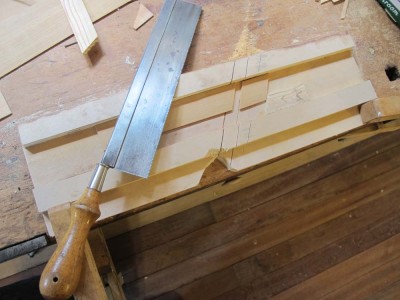 Fortunately it requires only the simplest jig and fairly careful layout and execution. I make a mitering jig with parallel fences on front and rear – the wider and thicker the better — with the space between them slightly greater than the width of the veneer strips being cut into rhomboids.
Fortunately it requires only the simplest jig and fairly careful layout and execution. I make a mitering jig with parallel fences on front and rear – the wider and thicker the better — with the space between them slightly greater than the width of the veneer strips being cut into rhomboids. 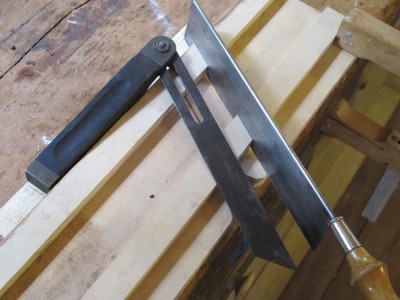 Using a 30-60-90 triangle establish a 60-degree angle on your bevel gauge, then set that gauge against the rear edge of the back fence and cut the kerf. It is critical to get this angle correct, it must be 60-degrees. Not, 59, not 59 ½, but 60 (well, 59.9 might work). When engaging in a fairly large scale project I make new kerfs somewhat frequently to mitigate the compounding error of wallowed out kerfs in the fences.
Using a 30-60-90 triangle establish a 60-degree angle on your bevel gauge, then set that gauge against the rear edge of the back fence and cut the kerf. It is critical to get this angle correct, it must be 60-degrees. Not, 59, not 59 ½, but 60 (well, 59.9 might work). When engaging in a fairly large scale project I make new kerfs somewhat frequently to mitigate the compounding error of wallowed out kerfs in the fences.  Since the width of the veneer stock can vary, for each run of parquetry a new spacer block needs to be placed for the rhombus being cut. To do this, simply place a piece of stop block stock in the saw and cut a small piece to be used as the angled stop block. Then take a piece of the veneer strip in the jig and saw off a small section at the 60-degree angle. Leaving the saw in place, fully embedded in the jig, rotate and flip that off-cut so that the recently sawn edge is now against the rear fence, and the side formerly against the rear fence is loosely against the saw blade. Place the spacer block against the edge of the off-cut and tack it in place, and you have a setup for making perfectly identical “lozenges” for composing the pattern.
Since the width of the veneer stock can vary, for each run of parquetry a new spacer block needs to be placed for the rhombus being cut. To do this, simply place a piece of stop block stock in the saw and cut a small piece to be used as the angled stop block. Then take a piece of the veneer strip in the jig and saw off a small section at the 60-degree angle. Leaving the saw in place, fully embedded in the jig, rotate and flip that off-cut so that the recently sawn edge is now against the rear fence, and the side formerly against the rear fence is loosely against the saw blade. Place the spacer block against the edge of the off-cut and tack it in place, and you have a setup for making perfectly identical “lozenges” for composing the pattern. 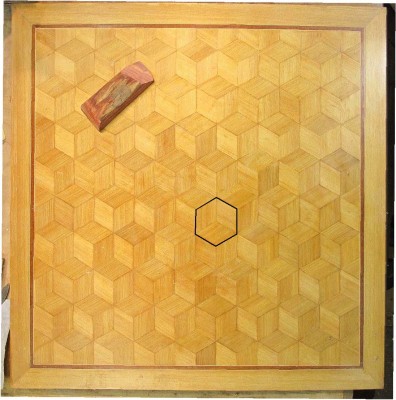 To check the accuracy of the set-up cut three pieces of the veneer strip stock and place them in the “dice” pattern. Make sure that the angles meet perfectly in the center of the pattern. If they do not, you need to lay out and cut another kerf until you get it right. Also, make sure that the sawn edge of the rhombus is EXACTLY the same length as the un-sawn edge. If it does not, tap the stop block towards or away from the saw a tiny bit until you get the dimension right.
To check the accuracy of the set-up cut three pieces of the veneer strip stock and place them in the “dice” pattern. Make sure that the angles meet perfectly in the center of the pattern. If they do not, you need to lay out and cut another kerf until you get it right. Also, make sure that the sawn edge of the rhombus is EXACTLY the same length as the un-sawn edge. If it does not, tap the stop block towards or away from the saw a tiny bit until you get the dimension right. 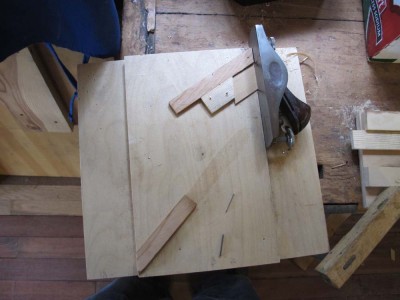 Another very useful jig is a dual shooting board with one fence at the 60-degree angle to adjust any lozenges (as you progress, it is almost inevitable that some inaccuracies will compound and need to be rectified) and a second fence at 45-degrees, to make perfect the ends of the banding where the pieces meet at the corner.
Another very useful jig is a dual shooting board with one fence at the 60-degree angle to adjust any lozenges (as you progress, it is almost inevitable that some inaccuracies will compound and need to be rectified) and a second fence at 45-degrees, to make perfect the ends of the banding where the pieces meet at the corner.
Among my recollections and acknowledgements from the recent MJD auction is to thank again Martin Donnelly himself for encouraging me to spread the Studley Exhibit gospel among the attendees. From the auctioneer’s podium at the initiation of activities, he announced the exhibit, pointed me out by name, and encouraged attendees to speak with me about it.
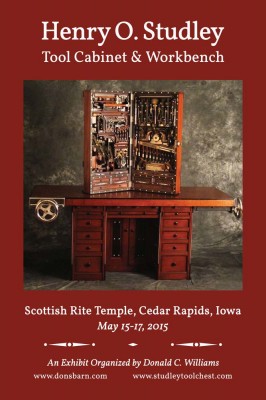
Martin also welcomed the stack of announcement post cards I’d brought with me, and they were right next to the sign-in station the whole weekend. (If you would like some to share and help promote the exhibit, just drop me a line via this web site’s “Contact” function and I will try to get you what you need.)
Like I said in a previous post, there are an awful lot of great folks in the tool world, and Martin Donnelly is certainly royalty in that world.
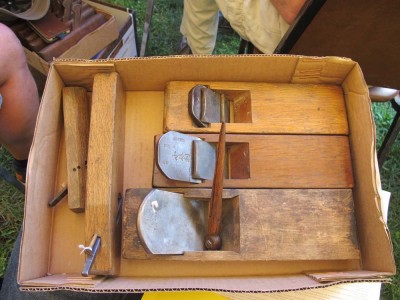
After having been shut out for the first 4/5ths of the auction I managed to snatch two lots late on Saturday morning. I’ve already mentioned the Lamson machinist’s lathe I got but I also garnered this nice lot of Japanese planes and a really neat bamboo divider. The largest plane had never been used, but the others were well polished, both wood and cutting edge, by multitudes of handlings. I can’t wait to get them all up and running and integrated into my activities in The Barn.
As always you leave events like this with a mixture of aggravation at not getting what you wanted and exhilaration at getting some things you didn’t expect.
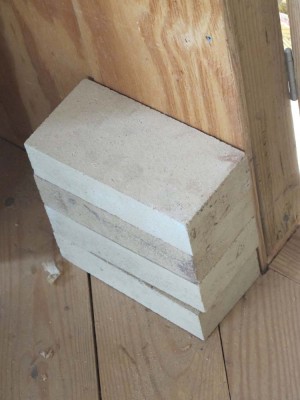
A recent visitor to the shop noticed a stack of bricks next to the door.
“What’s with them?” he asked.
Actually I find nice clean bricks to be useful in a multitude of ways in the shop, but perhaps none is more valuable than acting simply as a clean, dense, dead weight when I need to glue something but don’t need any more clamping power than to simply hold something in place while the adhesive dried.
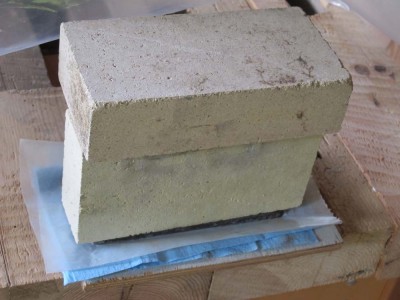
Here is a small irregularly shaped piece of broken iron that I am epoxying back together. There is no real way to clamp it even if I wanted to, so simply aligning it on a sand bag and letting the brick hold it steady and all is well.

Or, when assembling a large-ish panel, they do the trick wonderfully; just hold everything steady for a while.
Bricks also are a source of nearly identical spacers and I use a brick or several at least one time a week. An old friend actually glued felt on the sides of bricks and used them as weights ween on finished surfaces.
A final use that warms me, literally, is to sit a pair of bricks on top of the kerosene heater in the winter. They get hot and radiate heat wonderfully into the space, increasing the output efficiency of the system.
I’m partial to firebricks myself and am still using the pile I bought twenty years ago.
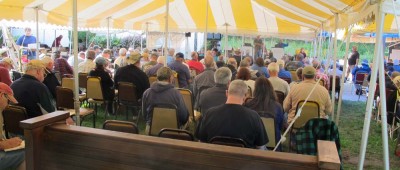
This year at Martin Donnelly’s annual warehouse-clearing auction of 75,000 tools in 3200 lots over 20 hours of auctioneering, I sat in a cluster with new friends Martin from Dayton and Jim from Boston, along with older friend Josh Clark from Hyperkitten Tools and my long time friend Jon Szalay, one of the very smartest guys I know.
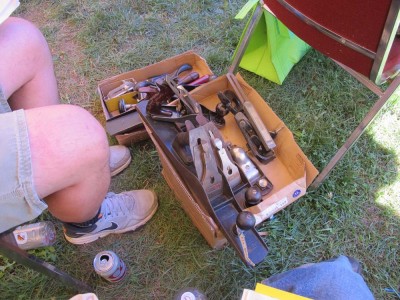
Josh’s business of buying lots of quality tools needing some TLC, tuning them and then reselling them for a modest prices is a tremendous boon to woodworkers coast-to-coast. He was having as successful an auction as mine was not. Time after time he would get a solid lot of tools, each one containing some, sometimes very many, tools that would fit nicely into his inventory.
Fortunately for me, on occasion these box lots contained items he did not really want but I really did, so plenty of sub-rosa horse trading was going on.
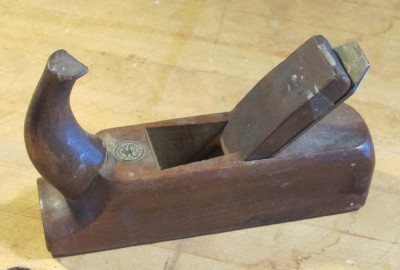
The first item we transferred from him to me was a horned scrub plane for my friend Dave, who has caught the hand-tool bug with a vengeance. I’ll tune that up and send it to him next week.
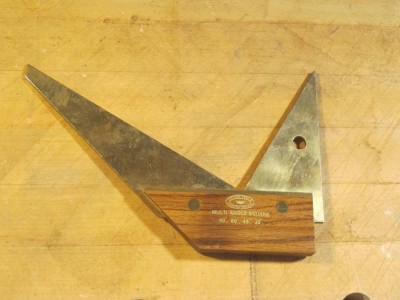
Next came a snazzy but weird layout template which features 90-45-30-60 degree angles, perfect for my use in making simple French parquetry.

It bears a remarkable resemblance to the marking template featured in Roubo’s Pate 14. Hmmm.
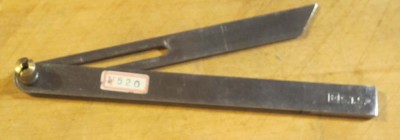
Also in the same lot was an excellent little Japanese-style bevel gauge, the smaller version of one I already had. Josh felt this tool was outside the interests of most of his customers, so I bought it to include in my traveling tool kit.

Finally, Josh implored me to take a very nice Stanley miter box off his hands so he would not have to pack it up. Being a generous sort of fellow, I accepted it. Just to help him out.
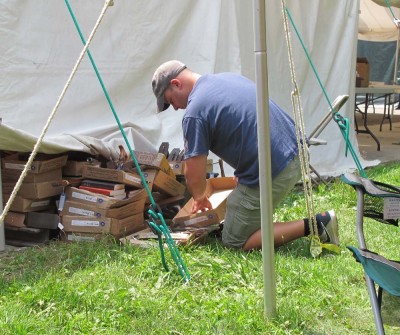
Spending those days aside Josh was a delightful interlude of good-natured tool chat and tale telling, and I strongly urge you to follow his web site and patronize his business. You will not be sorry.
Thanks Josh!

photo courtesy of Joshua Klein
Jon Szalay is someone I’ve known for many years through our membership and participation in the Professional Refinisher’s Group, an online forum that is part of our every day surfing. His presence was prominent in our recent Groopstock ’14 gathering at The Barn.
Jon is one of the most talented and inventive guys I know, he’s an antiques dealer, machinist, vintage motorcycle expert (he’s renowned for taking a 1911 Harley motorcycle on a transcontinental road trip, “Fix and repair hourly” he quips, and is the “go to” guy for the American Pickers crew), metal caster, carver and artist, the list goes on and on.
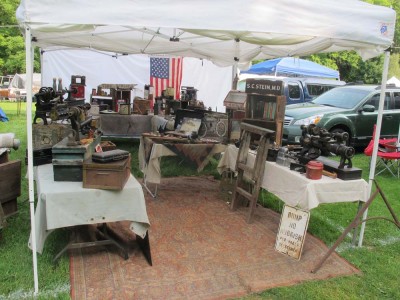
Jon had a booth at the tailgating section, and was somewhat overwhelmed by the scope of the auction. “I don’t know where to begin!” he said on more than one occasion.
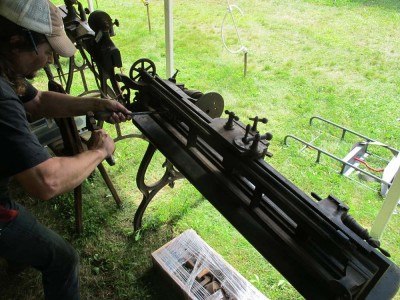
What eventually drew his eye was a mid-19th century machinist’s lathe, and with his encouragement I bought it for us to restore together (unlike most lots, it went for WAY under the estimate). We’ll get together this fall at The Barn to complete the task and for him to help me set up my blast furnace so metal casting can be part of the ongoing activities there.

























Recent Comments